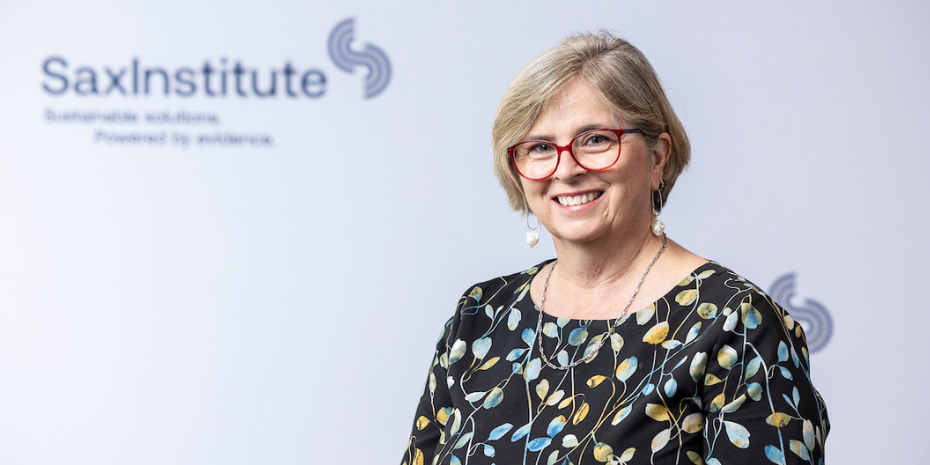
Falling on March 13 this year, Swallowing Awareness Day is an opportunity to raise awareness around an issue affecting around 1 million Australians. Eating, drinking, and swallowing are all essential activities that we take for granted but can cause significant problems for some people. Swallowing difficulties, or dysphagia, can seriously impact on people’s lives, leading to health issues and even death.
The Sax Institute sat down with Professor Bronwyn Hemsley, 2023 winner of a Sax Institute Research Action Award for her outstanding work on providing safe and enjoyable meals for people with swallowing disability, to talk about the issues around swallowing difficulties.
Q. Why is it so important to address the issue of swallowing difficulties and how many people are affected?
Professor Hemsley: It’s estimated about eight percent of the world’s population have dysphagia, or difficulty swallowing. The reason this figure is so high is because there are so many different health conditions that result in swallowing difficulty. For example, it affects many people with cerebral palsy, intellectual disability or cleft palate, and also many people with acquired conditions, such as when you’ve been able to swallow normally, but then something might happen like a traumatic brain injury, a stroke, or the onset of a neurological disease which affects your swallowing abilities.
Q. What are the dangers of dysphagia, and what should people who have swallowing difficulties (or their carers) do about it?
Professor Hemsley: The point at which we swallow is very close to our airway, so if you have trouble with chewing or swallowing, food can end up in your lungs and cause an infection, or it can block your airway and you can choke, which can be fatal. Choking can happen to anyone, but young children, people with disability, and older people are particularly at risk.
If you’re having problems swallowing – maybe you’re taking longer to swallow, or you’ve been choking or coughing while eating or drinking – you should see a speech pathologist and your GP. There’s a lot that these health professionals can do to help reduce the risk of breathing in food or choking. And there’s a wider team who can also step in to help, including a dietitian, occupational therapist, and physiotherapist, depending on need.
Q. If you see someone choking, what should you do?
Professor Hemsley: Choking is very distressing both for the person and for people nearby. Choking can be silent, where the person might suddenly stop talking, and clutch at their neck. They might even stand up to leave the table. Their eyes might be watering, and they might look distressed. The tragic thing is that bystanders often don’t know what to do, or forget in the moment, and ‘freeze’ rather than move decisively to act to save a life. And this is where First Aid training comes in, it might just help people move to take that first step of action.
The advice from St John Ambulance is if you see someone you think is choking, encourage them to relax, and ask them to cough. If still a problem, then call 000 for an ambulance, lean the person well forward and do five back blows, each time checking if it is cleared. There are some more steps you can take, and the paramedics on the call will step you through those until they arrive. People who witness a choking incident often need some support afterwards to talk it through. And people who survive a choking incident often need some help to manage ‘fear of choking’ and talk through ways to prevent it happening in the future.
Q. How has the landscape changed in terms of help for people with swallowing difficulties?
Professor Hemsley: Sadly, I never met my own Grandmother on my Dad’s side, as she died with gradually increased difficulty swallowing in the 1940s when my Dad was just a teenager. Back then, nobody knew why she had this trouble or what to do for her. So, she gradually lost more and more weight and the family were trying to give her anything at all to help keep her nourished.
Fortunately, since then, we’ve come a long way. We know a lot more about the symptoms and what causes swallowing difficulty, how to modify the texture of foods, and how to train supporters in ways to make food that’s the right texture and looks good, and there are tube feeds for people who cannot manage to eat enough food or swallow safely. We have treatments, rehab, and habilitation tailored to the person’s individual needs, and the best positioning, equipment, food textures, and mealtime assistance for their safe meals.
But nowadays we’re also paying more attention to the ‘shape’ of texture-modified foods. Moving on from just using an ice-cream scoop, where all different pureed foods were the same round shape, a technology that’s been very useful in aged care is food moulds, which can make pureed food look much more appetising and more like the usual foods on the plate. We’ve also been researching 3D food printing as a promising technology, to see if it will enable people to have a more attractive looking pureed meal. But we’re not at the point of being able to scale up that technology, since 3D food printers need to advance substantially and be co-designed with people with swallowing difficulty and their carers or service providers to be really useful.
Q. In terms of your own research, what areas are you looking at now and in the next few years?
Professor Hemsley: My team has looked a lot at food-shaping and the quality-of-life and nutritional impacts of swallowing problems for older people. One of the next things we need to do is create and test a tool to measure those impacts on quality of life properly. I’d also like to look more closely at hospital mealtimes. We know family members are often called upon to provide mealtime assistance for people with trouble swallowing, and yet they are likely to have no training in how to do this safely on the wards. And the provision of assistance to eat can be just as important as the food provided.
Another area we’ve been interested in is people with disability eating out. We’ve just done a systematic review called Craving Inclusion, published in Disability and Rehabilitation, in which we analysed 36 studies about the views and experiences of people with disability eating out in restaurants and cafes.
We found that there’s very little research around what happens when people with swallowing trouble go to a cafe or a restaurant. There might be nothing they can eat on the menu, and they still encounter quite a bit of discrimination in restaurants. Staff might not understand that the person with disability needs more room for the wheelchair, or more time to order and eat. They may need the menu items to be softer, cut up, with sauce, or pureed. They may cough, and some may be a little messy when eating that requires greater understanding and acceptance. I want to look at what we can do to make the whole of society more inclusive and aware of all these issues. And let’s get started on seeing how artificial intelligence could help with mealtime management, menu planning, and customising meals to a person’s individual needs.
Q. Has winning a Research Action Award had any impact on your research?
Professor Hemsley: It has certainly helped to raise awareness of the team’s work and highlighted the importance and priority of considering safe and enjoyable mealtimes. It also made me much more aware of the importance of the Sax Institute’s 45 and Up Study. Something we don’t know yet is how many people have this problem of trouble swallowing as they get older – we only have estimates – and importantly we don’t know at what age it starts for people with different health conditions. We’ve asked for funding to add a question to the 45 and Up Study survey on whether participants have choked on food in the past year, which would help us understand a bit more about the problem and who to direct education and awareness to. The message is that swallowing difficulties aren’t just a normal part of ageing that you need to live with: we can do something to help people enjoy their meals, get the right nutrition, have a good quality of life, and avoid choking.
Learn more about swallowing difficulty here.
Learn more about responding to choking here.
Find out more about Professor Hemsley’s work here.
Find out more about the Sax Institute’s Research Action Awards here.




